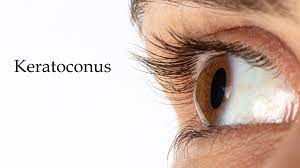The eye condition keratoconus is characterised by increasing corneal thinning and changes in corneal shape. The cornea, is the transparent, central portion of the front surface of the eye and often resembles a ball and is rounded.
However, occasionally the cornea’s structure is insufficiently robust to maintain this spherical form. The eye’s normally spherical surface might develop a cone-like outgrowth over time. This disorder is called keratoconus.

Usually, keratoconus is discovered in adolescence or early adulthood, although it can sometimes develop in childhood. Over a few years, the cornea’s form changes, however more quickly in younger people. There are many keratoconus treatment in india that can be cured.
How Keratoconus can affect a Person?
The smooth surface warps when the cornea transforms from a ball to a cone. The term for this variation is irregular astigmatism, which eyeglasses cannot completely fix.
The eye gets increasingly nearsighted when the front of the cornea steepens. The person could require new glasses more frequently as a result.
Symptoms of Keratoconus
In late adolescence, the vision in one or both eyes gradually deteriorates. Even with glasses on, the person may experience double vision while using only one eye.
Bright lights have the appearance of having haloes surrounding them.
A person with keratoconus will see that their eyesight gradually distorts. It is possible for the transformation to terminate at any point or to last for a long period. The majority of keratoconus patients eventually have vision loss in both eyes.
Keratoconus has a mainly unidentified aetiology. According to certain research, keratoconus is more common in patients with specific medical issues and runs in families. However, the majority of the time there is no eye illness or damage to account for the alteration in the eye. Keratoconus patients frequently touch their eyes, which might hasten the progression of the ailment. A patient must refer the doctor and take proper Keratoconus treatment in India.
Diagnosis of Keratoconus
The ophthalmologist must gauge the cornea’s curvature to diagnose keratoconus. The diagnosis can be made using a variety of tests. Topography is the exam that is most frequently employed. Topography generates a colourful “map” of the cornea by measuring the curvature of the eye’s surface. The appearance of these maps varies significantly in keratoconus, which enables the doctor to diagnose the condition.
Treatment of Keratoconus
Depending on how bad the issue is, keratoconus can be treated using a variety of techniques. Normal eyeglasses or soft contact lenses can be used to correct eyesight in the early stages of the condition. Because of the increasing quantity of uneven astigmatism brought on by keratoconus, the patient may need to be fitted with a particular kind of hard contact lens as the condition worsens and can be improvised by taking good Keratoconus Treatment in India.
Even with glasses or contact lenses, the illness may progress in some people to the point where their vision is no longer acceptable. A cornea transplant, which involves surgery to replace the cornea with a cornea from a donor, may be advised at this time.
Ayurvedic Keratoconus Treatment in India
This condition is classified as Vata vitiation in Ayurveda. The cornea is harmed by this. Therefore, doctors use vata Samana therapies to cure keratoconus. The most accurate explanation for this illness is vata dosha disruption at the corneal level. Vata dosha is located in the cornea. Additional Vata dosha stimulation causes a variety of morphological and physiological alterations in the cornea. The cornea’s shape is changed, becoming conical in form and becoming thinner in the middle.
Ayurvedic Eye Treatment like Netradhara, Nasya, Lepa over the eyes, Shirodhara, and Tharpana are extremely effective methods that can stop the condition from progressing further. Additionally, keratoconus eye drops are utilised to treat the patient’s symptoms. Treatment for keratoconus involves long-term symptom monitoring along with several dietary and lifestyle limitations.
All things that increase vata should be avoided, such as processed meals, spending long hours in front of a computer or phone, sleeping late at night, having irregular bowel movements, etc. Future vision loss can be avoided with the aid of a healthy, balanced diet high in clarified butter (cow ghee), adequate sleep, a stress-free schedule, and regular physical activity. Medication is done based on the patient’s health and the disease’s clinical stage. Also, well-planned eye motions are practised to maintain the eyeball’s form and strengthen the eye muscles.
For keratoconus, there are several therapy options. In keratoconus, aschotanam, Netra tharpanam, and putapakam are helpful. Only a skilled hand should choose the medications for these surgeries. The goal of the Ayurvedic Keratoconus treatment in India is to make the cornea stronger so that it maintains its natural shape and does not protrude outward and increase the organ’s and nervous system’s functional ability to enhance vision.

As the editor of the blog, She curate insightful content that sparks curiosity and fosters learning. With a passion for storytelling and a keen eye for detail, she strive to bring diverse perspectives and engaging narratives to readers, ensuring every piece informs, inspires, and enriches.









